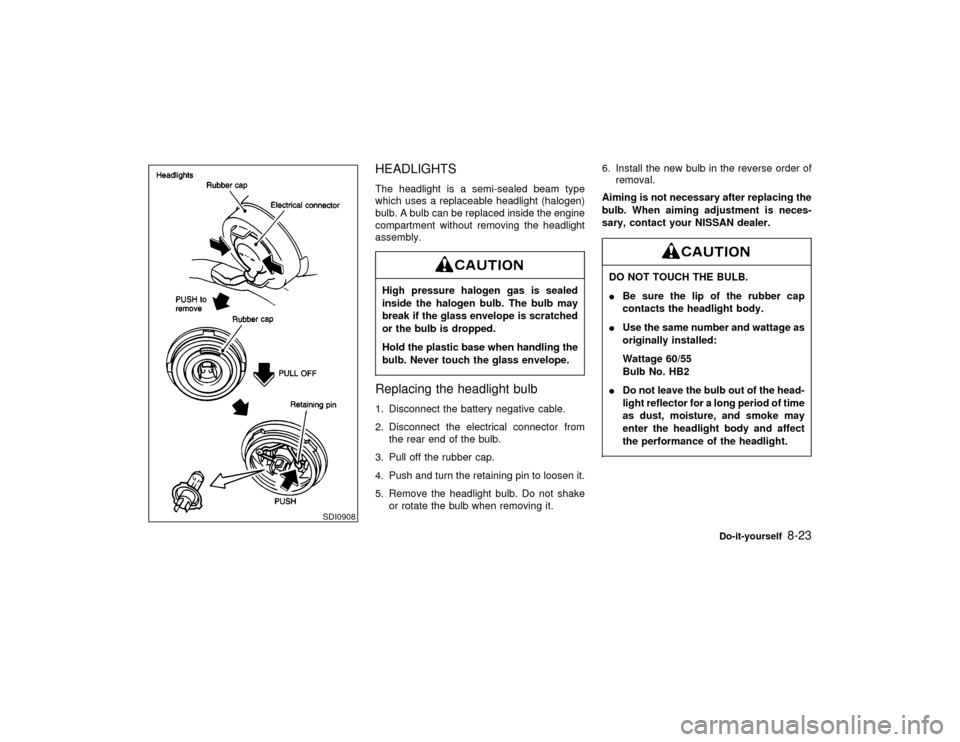battery NISSAN PATHFINDER 1999 R50 / 2.G Owner's Manual
[x] Cancel search | Manufacturer: NISSAN, Model Year: 1999, Model line: PATHFINDER, Model: NISSAN PATHFINDER 1999 R50 / 2.GPages: 274, PDF Size: 2.34 MB
Page 186 of 274

Always follow the instructions below
exactly. Failure to do so could result in
damage to the charging system and
cause personal injury.1. Position the two vehicles to bring their
batteries into close proximity to each other
if the booster battery is in another vehicle.
Do not allow the two vehicles to touch.
2. Apply parking brakes. Move the shift lever
to Neutral position (On automatic transmis-sion models, move the selector lever to P
(Park)). Switch off all unnecessary electri-
cal systems (light, heater, air conditioner,
etc.).
3. Remove vent caps on the battery (if so
equipped). Cover the battery with an old
cloth to reduce explosion hazard.
4. Connect jumper cables in the sequence as
illustrated.
IAlways connect positive (+) to posi-
tive (+) and negative (þ) to body
ground, (for example, engine lift
bracket, etc. Ð not to the battery).
IMake sure that cables do not touch
any moving parts in the engine com-
partment and that clamps do not con-
tact any other metal.5. Start the engine of the other vehicle and let
it run for a few minutes.
6. Keep the engine speed of the other vehicle
at about 2,000 rpm, and start your engine in
the normal manner.
Do not keep starter motor engaged for
more than 10 seconds. If the engine
does not start right away, turn the key
off and wait 3 to 4 seconds before trying
again.7. After starting your engine, carefully discon-
nect the negative cable and then the posi-
tive cable.
8. Replace the vent caps (if so equipped). Be
sure to dispose of the cloth used to cover
the vent holes as it may be contaminated
with corrosive acid.
SCE0149
In case of emergency
6-9
Z
01.1.22/R50-D/V5
X
Page 200 of 274

8 Do-it-yourselfMaintenance precautions .......................................... 8-2
Engine compartment check locations ....................... 8-3
Engine cooling system .............................................. 8-4
Checking engine coolant level .................................. 8-4
Changing engine coolant .......................................... 8-5
Engine oil .................................................................. 8-7
Checking engine oil level .......................................... 8-7
Changing engine oil .................................................. 8-8
Changing engine oil filter .......................................... 8-9
Automatic transmission fluid ..................................... 8-9
Temperature conditions for checking ...................... 8-10
Power steering fluid ................................................ 8-11
Brake and clutch fluid ............................................. 8-11
Brake fluid ............................................................... 8-11
Clutch fluid .............................................................. 8-12
Window washer fluid ............................................... 8-12
Window washer fluid reservoir ................................ 8-12
Battery ..................................................................... 8-13
Jump starting........................................................... 8-14
Drive belts ............................................................... 8-14
Spark plugs ............................................................. 8-15
Replacing spark plugs ............................................. 8-15Air cleaner ............................................................... 8-16
Windshield wiper blades ......................................... 8-17
Cleaning .................................................................. 8-17
Replacement ........................................................... 8-17
Parking brake and brake pedal ............................... 8-18
Checking parking brake .......................................... 8-18
Checking brake pedal ............................................. 8-19
Brake booster .......................................................... 8-19
Clutch pedal ............................................................ 8-20
Checking clutch pedal ............................................. 8-20
Fuses....................................................................... 8-20
Engine compartment ............................................... 8-20
Passenger compartment ......................................... 8-21
Lights ....................................................................... 8-22
Headlights ............................................................... 8-23
Tires and wheels ..................................................... 8-26
Tire pressure ........................................................... 8-26
Types of tires .......................................................... 8-27
Tire chains............................................................... 8-28
Changing tires and wheels...................................... 8-28
Clutch housing drain ................................... 8-31
Z
01.1.22/R50-D/V5
X
Page 201 of 274

When performing any inspection or mainte-
nance work on your vehicle, always take care
to prevent serious accidental injury to yourself
or damage to the vehicle. The following are
general precautions which should be closely
observed.IPark the vehicle on a level surface,
apply the parking brake securely and
block the wheels to prevent the ve-
hicle from moving. For a manual
transmission, move the shift lever to
Neutral. For an automatic transmis-
sion, move the selector lever to P
(Park).
IBe sure the ignition key is in the OFF
or LOCK position when performing
any replacement or repair.
IIf you must work with the engine
running, keep your hands, clothing,
hair and tools away from moving fans
and fan belts.
IIt is advisable to remove necktie and
any jewelry, such as rings, watches,
etc. before working on your vehicle.IAlways wear eye protection when-
ever you work on your vehicle.
IIf you must run the engine in an
enclosed space such as a garage, be
sure there is proper ventilation for
exhaust gases.
INever get under the vehicle while it is
supported only by a jack. If it is nec-
essary to work under the vehicle,
support it with safety stands.
IKeep smoking materials, flame and
sparks away from fuel and battery.
IThe fuel filter or fuel lines should be
serviced by a NISSAN dealer because
the fuel lines are under high pressure
even when the engine is off.
IDo not work under the engine hood
while it is hot. Always turn off the
engine and wait until it cools down.
INever connect or disconnect either
the battery or any transistorized com-ponent connector while the ignition
key is on.
IAvoid direct contact with used engine
oil. Improperly disposed motor oil and/
or other vehicle fluids can hurt the
environment. Always conform to lo-
cal regulations for disposal of vehicle
fluid.
This ª8. Do-it-yourselfº section gives instruc-
tions regarding only those items which are
relatively easy for an owner to perform.
You should be aware that incomplete or im-
proper servicing may result in operating diffi-
culties or excessive emissions, and could af-
fect your warranty coverage.If in doubt about
any servicing, have it done by your NISSAN
dealer.
MAINTENANCE PRECAUTIONS8-2
Do-it-yourself
Z
01.1.22/R50-D/V5
X
Page 212 of 274

For CANADAAdd fluid when the low washer fluid warning
light comes on. Add a washer solvent to the
water for better cleaning. In the winter season,
add a windshield washer anti-freeze. Follow
the manufacturer's instructions for the mixture
ratio.Do not substitute engine anti-freeze
coolant for window washer solution.
This may result in damage to the paint.
Anti-freeze is poisonous and should be
stored carefully marked containers out
of the reach of children.
IKeep the battery surface clean and dry. Any
corrosion should be washed off with a
solution of baking soda and water.
IMake certain the terminal connections are
clean and securely tightened.
IIf the vehicle is not to be used for 30 days or
longer, disconnect the (Ð) negative battery
terminal cable to prevent discharge.IDo not expose the battery to flames
or electrical sparks. Hydrogen gas
generated by battery action is explo-
sive. Do not allow battery fluid to
contact your skin, eyes, fabrics, or
painted surfaces. After touching a
battery or battery cap, do not touch or
rub your eyes. Thoroughly wash your
hands. If the acid contacts your eyes,
skin or clothing, immediately flush
with water for at least 15 minutes and
seek medical attention.
IWhen working on or near a battery,
always wear suitable eye protection
and remove all jewelry.
IKeep the battery out of the reach of
SDI0389
BATTERY
Do-it-yourself
8-13
Z
01.1.22/R50-D/V5
X
Page 213 of 274

children.
JUMP STARTINGIf jump starting is necessary, see ªJump start-
ingº in the ª6. In case of emergencyº section. If
the engine does not start by jump starting, the
battery may have to be replaced. Contact your
NISSAN dealer.
Check the fluid level in each cell. It should be
between the MAX. and MIN. lines.
If it is necessary to add fluid, add only distilled
water to bring the level to the indicator in each
filler opening.Do not overfill.
1. Remove the cell plugs using a suitable tool.
2. Add distilled water up to the MAX. level.
3. Tighten cell plugs.
Be sure the ignition key is OFF. The
engine could rotate unexpectedly.1. Visually inspect each belt for signs of un-
usual wear, cuts, fraying or looseness. If
the belt is in poor condition or loose, have it
replaced or adjusted by your NISSAN
dealer.
2. Have the belts checked regularly for condi-
tion and tension in accordance with the
maintenance schedule in this manual.
DI0137M
SDI0424
DRIVE BELTS
8-14
Do-it-yourself
Z
01.1.22/R50-D/V5
X
Page 222 of 274

HEADLIGHTSThe headlight is a semi-sealed beam type
which uses a replaceable headlight (halogen)
bulb. A bulb can be replaced inside the engine
compartment without removing the headlight
assembly.High pressure halogen gas is sealed
inside the halogen bulb. The bulb may
break if the glass envelope is scratched
or the bulb is dropped.
Hold the plastic base when handling the
bulb. Never touch the glass envelope.Replacing the headlight bulb1. Disconnect the battery negative cable.
2. Disconnect the electrical connector from
the rear end of the bulb.
3. Pull off the rubber cap.
4. Push and turn the retaining pin to loosen it.
5. Remove the headlight bulb. Do not shake
or rotate the bulb when removing it.6. Install the new bulb in the reverse order of
removal.
Aiming is not necessary after replacing the
bulb. When aiming adjustment is neces-
sary, contact your NISSAN dealer.
DO NOT TOUCH THE BULB.
IBe sure the lip of the rubber cap
contacts the headlight body.
IUse the same number and wattage as
originally installed:
Wattage 60/55
Bulb No. HB2
IDo not leave the bulb out of the head-
light reflector for a long period of time
as dust, moisture, and smoke may
enter the headlight body and affect
the performance of the headlight.
SDI0908
Do-it-yourself
8-23
Z
01.1.22/R50-D/V5
X
Page 235 of 274

uneven effort. Keep the floor mats away from
the pedal.
Clutch pedal*:
Make sure the pedal operates smoothly and
check that it has the proper free travel.
Brakes:
Check that the brakes do not pull the vehicle to
one side when applied.
Brake pedal and booster*:
Check the pedal for smooth operation and
make sure it has the proper distance under it
when depressed fully. Check the brake
booster function. Be certain to keep floormats
away from the pedal.
Parking brake*:
Check that the lever has the proper travel and
confirm that your vehicle is held securely on a
fairly steep hill with only the parking brake
applied.
Automatic transmission P position
mechanism:
On a fairly steep hill check that your vehicle is
held securely with the selector lever in the P
position without applying any brakes.
Under the hood and vehicleThe maintenance items listed here should be
checked periodically e.g. each time you check
the engine oil or refuel.
Windshield washer fluid*:
Check that there is adequate fluid in the tank.
Engine oil level*:
Check the level after parking the vehicle on a
level spot and turning off the engine. (Be sure
to wait a few minutes to allow the oil to drain
back into the sump.)
Brake and clutch fluid levels*:
Make sure that the brake and clutch fluid level
is between the MAX and MIN lines on the
reservoir.
Power steering fluid level* and lines:
Check the level when the fluid is cold and the
engine is turned off. Check the lines for proper
attachment, leaks, cracks, etc.
Automatic transmission fluid level*:
Check the level after putting the selector lever
in P (Park) with the engine idling.Engine coolant level*:
Check the coolant level when the engine is
cold.
Radiator and hoses:
Check the front of the radiator and clean off
any dirt, insects, leaves, etc., that may have
accumulated. Make sure the hoses have no
cracks, deformation, rot or loose connections.
Engine drive belts*:
Make sure that no belt is frayed, worn, cracked
or oily.
Battery*:
Check the fluid level in each cell. It should be
between the MAX and MIN lines.
Exhaust system:
Make sure there are no loose supports, cracks
or holes. If the sound of the exhaust seems
unusual or there is a smell of exhaust fumes,
immediately locate the trouble and correct it.
See ªPrecautions when starting and drivingº in
the ª5. Starting and drivingº section for exhaust
gas (carbon monoxide).
Underbody:
The underbody is frequently exposed to corro-
sive substances such as those used on icy
9-4
Maintenance
Z
01.1.22/R50-D/V5
X
Page 262 of 274

If you believe that your vehicle has
a defect which could cause a crash
or could cause injury or death, you
should immediately inform the Na-
tional Highway Traffic Safety Ad-
ministration (NHTSA) in addition to
notifying NISSAN.
If NHTSA receives similar com-
plaints, it may open an investiga-
tion, and if it finds that a safety
defect exists in a group of vehicles,
it may order a recall and remedy
campaign. However, NHTSA can-
not become involved in individual
problems between you, your dealer,
or NISSAN.
To contact NHTSA, you may either
call the Auto Safety Hotline toll-free
at 1-800-424-9393 (or 366-0123 in
Washington, D.C. area) or write to:
NHTSA, U.S. Department of Trans-
portation, Washington, D.C. 20590.
You can also obtain other informa-
tion about motor vehicle safety from
the Hotline.You may notify NISSAN by contact-
ing our Consumer Affairs Depart-
ment, toll-free, at 1-800-NISSAN-1.
In Hawaii call (808) 836-0888.
Due to legal requirements in some states/
areas, your vehicle may be required to be in
what is called the ªready conditionº for an
Inspection/Maintenance (I/M) test of the emis-
sion control system.
The vehicle is set to the ªready conditionº
when it is driven through certain driving pat-
terns. Usually, the ready condition can be
obtained by ordinary usage of the vehicle.
If a powertrain system component is repaired
or the battery is disconnected, the vehicle may
be reset to a not ready condition. Before taking
the I/M test, drive the vehicle through the
following pattern to set the vehicle to the ready
condition. If you cannot or do not want to
perform the driving pattern, an NISSAN dealer
can conduct it for you.Always drive the vehicle in a safe man-
ner according to traffic conditions and
obey all traffic laws.1. Start the engine when the engine coolant
temperature gauge needle points to C. Al-
low the engine to idle until the gauge needle
points between the C and H (normal oper-
ating temperature).
REPORTING SAFETY DEFECTS
(US only)READINESS FOR INSPECTION/
MAINTENANCE (I/M) TEST (US
only)
Technical and consumer information
10-19
Z
01.1.22/R50-D/V5
X
Page 266 of 274

11 Index
A
ABS (Anti-lock brake system) ......................... 5-25
Air bag
Warning labels........................................... 1-20
Warning light .................................... 1-20, 2-10
Air bag system (See supplemental restraint
system) ........................................................... 1-16
Air bag system, side (See supplemental side air
bag system) .................................................... 1-10
Air cleaner housing filter ................................. 8-16
Air conditioner
Air conditioner operation ...................... 4-3, 4-9
Air conditioner service ................ 4-3, 4-9, 4-11
Air conditioner specification
label .......................................... 4-3, 4-9, 10-13
Air conditioner system refrigerant and
lubrication recommendations ............... 4-3, 4-9
Heater and air conditioner (automatic) (if so
equipped)..................................................... 4-9
Heater and air conditioner controls ............. 4-3
Servicing air conditioner .............................. 4-3
Air conditioning system refrigerant and lubricant
recommendations ........................................... 10-8
Air flow charts ............................................ 4-6, 4-9
Alcohol drugs and driving ................................. 5-4
AM-FM radio with cassette player .................. 4-12
AM-FM radio with cassette player and compact
disc player....................................................... 4-12
AM-FM radio with compact disc player .......... 4-12Anchor point locations
Top tether strap ......................................... 1-40
Antenna
Manual ....................................................... 4-25
Power ........................................................ 4-25
Anti-lock Brake System (ABS) ........................ 5-25
Anti-lock brake warning light........................... 2-11
Appearance care
Exterior appearance care ............................ 7-2
Interior appearance care ............................. 7-3
Armrest ............................................................. 1-9
Ashtray (See cigarette lighter and ashtray) .... 2-25
Audio system .................................................. 4-12
Automatic
Automatic transmission fluid (ATF) ............. 8-9
Sunroof ...................................................... 2-34
Avoiding collision and rollover .......................... 5-4
B
Battery............................................................. 8-13
Battery replacement, (See multi-remote control
system) ............................................................. 3-8
Before starting the engine ................................ 5-8
Belts (See drive belts) .................................... 8-14
Brake
Anti-lock brake system (ABS) ................... 5-25
Brake and clutch fluid................................ 8-11
Brake booster ............................................ 8-19
Brake fluid ................................................. 8-11Brake pedal ............................................... 8-18
Brake pedal check..................................... 8-19
Parking brake check ........................ 5-15, 8-18
Parking brake operation ............................ 5-15
System....................................................... 5-25
Warning light ............................................. 2-11
Break-in schedule ........................................... 5-18
Bulb check/instrument panel ............................ 2-9
Bulb replacement ............................................ 8-22
C
Capacities and recommended
fuel/lubricants .................................................. 10-2
Car phone ....................................................... 4-26
Cassette player (See audio system) .............. 4-16
Cassette tape operation ................................. 4-12
Catalytic converter, Three way catalyst............ 5-3
CB radio or car phone .................................... 4-26
Cellular phone
Steering switch .......................................... 2-50
Switch operation ........................................ 2-51
Child restraints ................................................ 1-31
Installation on front passenger seat .......... 1-41
Installation on rear seat outboard
positions .................................................... 1-35
Installation on rear seat center position .... 1-32
Precautions on child restraints .................. 1-31
Top tether strap anchor point locations .... 1-40
With top tether strap.................................. 1-40
Z
01.1.22/R50-D/V5
X
Page 269 of 274

Loading information (See vehicle loading
information) ................................................... 10-13
Lock
Door locks ................................................... 3-2
Glass hatch lock ........................................ 3-11
Glove box lock........................................... 2-27
Power door lock .......................................... 3-2
Rear door opener ...................................... 3-10
Luggage hooks ............................................... 2-29
Luggage rack .................................................. 2-32
MMaintenance
Battery ....................................................... 8-13
General maintenance .................................. 9-2
Inside the vehicle ........................................ 9-2
Maintenance precautions ............................ 8-2
Outside the vehicle...................................... 9-2
Periodic maintenance schedules ................ 9-5
Seat belt maintenance .............................. 1-30
Under the hood and vehicle ........................ 9-4
Manual antenna .............................................. 4-25
Manual front seat adjustment ........................... 1-2
Map lights ....................................................... 2-35
Meters and gauges ........................................... 2-3
Mirror
Inside mirror .............................................. 3-15
Outside mirror control................................ 3-15
Outside mirrors .......................................... 3-15
Multi-remote control system.............................. 3-5N
New vehicle break-in ...................................... 5-18
OOdometer .......................................................... 2-3
Oil
Capacities and recommended fuel/
lubricants ................................................... 10-2
Changing engine oil .................................... 8-8
Changing engine oil filter ............................ 8-9
Checking engine oil level ............................ 8-7
Engine oil..................................................... 8-7
Engine oil viscosity .................................... 10-6
Outside mirror control ..................................... 3-15
Outside mirror defogger .................................. 2-18
Outside mirrors ............................................... 3-15
Outside temperature display ............................. 2-6
Overdrive switch ............................................. 5-12
Overheat, If your vehicle overheats................ 6-10
PParking
Brake check............................................... 8-18
Parking brake check.................................. 5-15
Parking brake operation ............................ 5-15
Parking/parking on hills ............................. 5-15
Warning light/indicator lights and chimes ... 2-9
Parking/parking on hills .................................. 5-23
Password, Infiniti Communicator .................... 2-50
Periodic maintenance schedules ...................... 9-5
Personal lights ................................................ 2-36Power
Power antenna .......................................... 4-25
Power door lock .......................................... 3-2
Power steering fluid................................... 8-11
Power steering system .............................. 5-24
Socket........................................................ 2-24
Precautions
Cruise control precautions ........................ 5-16
Maintenance precautions ............................ 8-2
On child restraints ..................................... 1-31
On seat belt usage .................................... 1-23
On supplemental restraint system ............ 1-10
On-pavement and offroad driving
precautions .................................................. 5-3
Precautions when starting and driving ........ 5-2
Pre-tensioner seat belt system ....................... 1-18
Push starting ................................................... 6-10
R
Rack, Luggage rack ........................................ 2-32
Radio, CB radio or car phone......................... 4-26
Readiness for inspection/maintenance (I/M) test
(USA only) .................................................... 10-19
Rear door ........................................................ 3-10
Rear door lock ................................................ 3-10
Child safety rear door lock .......................... 3-4
Rear door opener ........................................... 3-10
Rear power point ............................................ 2-24
Rear seat adjustment ....................................... 1-6
Rear window wiper and washer switch .......... 2-17
Registering your vehicle in another
country .......................................................... 10-11
Z
01.1.22/R50-D/V5
X
11-4